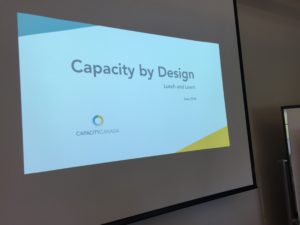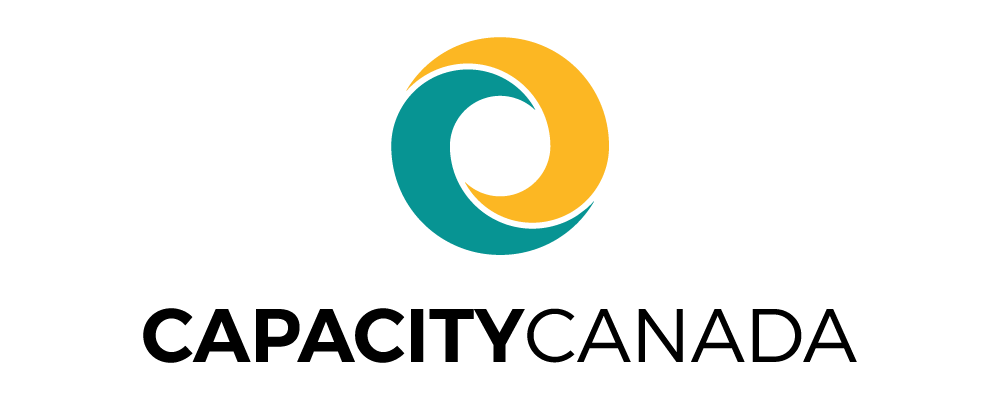Capacity Canada has taken a big step forward with its Capacity by Design program to increase the impact of non-profit organizations.
The new initiative is based on the human-centred approach of design thinking to provide non-profits with creation options when problem solving. To help bring it to life, Capacity Canada has enlisted the services of two experts in the field of marketing and evaluation.
Hugh Munro, retired Wilfrid Laurier University marketing professor and strategy and marketing consultant for H & S Munro Associates Ltd., along with Evaluation Manager Liz Dennis, are now hard at work learning about design thinking and how to share that knowledge with other non-profits to help them solve problems.

“It’s a big project, but that’s what drew me to it,” said Dennis. “It’s such an exciting opportunity to learn this approach.”
Munro, a facilitator for Capacity Canada’s successful Board Governance BootCamp program, agreed and said the concept of design thinking is a great way to help build stronger communities.
“When I saw what Capacity Canada was trying to do, I was very keen to make a difference and in particular, saw an opportunity to do that through design thinking,” he said, adding it was a perfect ‘alignment’ when he became part of the Capacity by Design team.
Capacity by Design, which is being created in partnership with Kitchener-based design thinking consulting firm Overlap Associates, ramps up in September when the first of six five-day design sprints will be held for a select group of local and national non-profits.
Work on the program kicked off in March of this year when the Lyle S. Hallman Foundation provided $417,940 to cover the costs of the first year. The foundation has committed a total of $1.1 million over four years.
Since April the Capacity by Design team, which includes design thinking experts from Overlap Associates, has been holding a series of ongoing labs to formulate the program. This includes the launch of a website (www.capacitybydesign.ca) and exploring potential non-profit candidates to participate in the design sprints to ‘test’ the program.
Munro and Dennis will play major roles in the creation of the program over the next year as well as its facilitation.

“Liz and Hugh will not only help develop Capacity by Design as a service, preparing for our design sprints, but continuing to develop relationships with organizations for whom Capacity by Design is a good match,” said Matthew Reynolds, who is spearheading the program for Capacity Canada. “Finally, like several others on the team, Liz and Hugh will be focusing on strong facilitation, and learning how to deliver design thinking to a wide variety of non-profit organizations.”
Dennis, who does work for the Peel Leadership Centre and is the former manager of content, strategy and communications for SPARK Ontario, has more than 15 years of experience working in the non-profit sector. She was first introduced to design thinking by a Toronto company while helping to develop a volunteering website as a legacy project of the 2015 Pan Am/Parapan Am Games.
“They took us through the whole experience process; Who will see this? Who are our user groups? What are their needs and wants?” she said. “For me, that was such a powerful thing. Going through that process of strategy and design really helped me with every other part of that site.”
Dennis said that experience assisted her and the organization to fine tune an effective engagement strategy during the second year the site was up and running.
“For me, it was very helpful,” she said, explaining that many who work in the non-profit sector, when asked, often believes they are serving ‘everybody’.
“That means nothing if you’re trying to figure out the most effective way to reach the people who really need us.”
Munro said he had some experience in design thinking during his teaching career and believe it’s a practice businesses and non-profits can benefit from.
“One of the ways to become more innovative is to take different thinking to the process and design thinking seemed to be a catalyst to innovation,” he said, adding he’s confident taking part in the Capacity by Design program will be beneficial to non-profits.

“Even if it (design sprints) doesn’t lead to the magic solution, that process of getting people to think differently will be helping them fish, but not giving them the fish. Maybe we’ll get the fish the next time.”
For Dennis, the design thinking process is a great way to ignite conversation and see what develops.
“To me, the magic is in the deep listening in the room and really trying to leverage what comes out,” she said. “If you can build momentum and energy in the room around the process and get them to think together, that’s amazing.”
Capacity Canada’s Lynn Randall, project sponsor of Capacity by Design, said the program will have a very flexible approach.
“Design sprints are a very niche thing and not every program will be sprintable,” she said, explaining the non-profit participants may discover their problems can be resolved through any number of Capacity Canada’s core programs.
“We’ve learned the program itself is probably a gateway into all our other services,” said Randall.
In an effort to determine what solution works best, she said the Capacity by Design team will not only work with the non-profits in identifying their problem but work with them in developing a usable prototype solution.

“While Capacity Canada is an education charity, we don’t just deliver educational programs. We actually help build capacity,” said Randall, adding that’s why the partnership with Overlap Associates works so well.
“Overlap’s mission or mandate is to democratize design thinking. They feel so strongly about it and they want all organizations to have these tools.”
Reynolds said the non-profit community has expressed much interest in the Capacity by Design program since it was first announced.
“Our recent lunch and learn event (held in June) saw that trend continue, and grew the pool of candidate organizations,” he said. “Since then we’ve had exploratory conversations with several and hope to announce the first participant organization shortly.”
For more information about Capacity by Design, contact Matthew Reynolds ([email protected]) or Lynn Randall ([email protected]).

